Performance of Porous Slabs Using Recycled Ash
Abstract
:1. Introduction
2. Materials and Methods
2.1. Materials
2.1.1. Fine Aggregate
2.1.2. Coarse Aggregate
2.1.3. Cement
2.1.4. Recycled Rice Straw Ash (RSA) and Recycled Wheat Straw Ash (WSA)
2.1.5. Super Plasticizer
2.1.6. Polypropylene Fibers
2.1.7. Geogrid
2.1.8. GFRP Bars
2.2. Description of Specimens for Phase I
2.3. Description of Specimens for Phase II
2.4. Experimental Tests for Phase I
2.4.1. Slump Test
2.4.2. Compacting Factor Test
2.4.3. Density
2.4.4. Compressive Strength
2.4.5. Split Tensile Strength
2.4.6. Flexural Strength
2.4.7. Permeability
2.4.8. Porosity
2.5. Experimental Tests for Phase II
3. Results and Discussion
3.1. Slump Test Results
3.2. Compaction Factor Test Results
3.3. Density Test Results
3.4. Compressive Test Results
3.5. Splitting Tensile Test Results
3.6. Flexural Test Results
3.7. Permeability Test Results
3.8. Porosity Test Results
3.9. Ultimate Load and Displacements
3.10. Ductility Ratio and Energy Absorption
3.11. Load-Deflection Relationship
3.12. Crack Patterns
4. NonLinear Finite Element Analysis
Modeling
5. Comparisons between Experimental and NLFEA Results
5.1. Ultimate Load
5.2. Ultimate Displacement
5.3. Cracking Patterns
6. Conclusions
- Rice and wheat straw ash gave accepted permeabilities and porosities with lower densities compared to the control mixes. This was attributed to the chemical compositions for rice and wheat straw ash.
- Rice and wheat straw ash increased the compaction factor due to their spherical shapes and higher surface area compared with the control mixes.
- Increasing the cement/aggregate ratio from 0.22 to 0.40 led to increases in the 28-day compressive strength, splitting tensile strength, and flexural strength.
- Using sand increased the compressive, splitting tensile and flexural strengths, with a significant decrease in porosity and permeability. This was attributed to the higher density, which reduced the void content. Thus, we recommend the use of sand with a percentage less than 10% for accepted permeability.
- The results showed that permeability and porosity increased slightly for mixes using rice and wheat straw ash. This could be attributed to increasing the interconnected voids. Optimum porosity was reached with 15% rice straw ash (Mix 7).
- The concrete mixes with higher porosity showed high water permeability and low compressive splitting tensile and flexural strengths. The results proved that porosity and compressive strength were in a reverse relationship.
- The void ratio should be controlled by employing polypropylene fibers, such as E300, to control the gap between the particles; consequently, the compressive strength will be increased.
- All the studied reinforced pervious concrete slabs provided an increase in ultimate loads and displacements compared to the unreinforced control slab.
- Pervious slabs reinforced by GFRP bars gave the highest ultimate load, followed by the slabs reinforced with geogrid, while the lowest ultimate load was for slabs with polypropylene fibers.
- A nonlinear study was performed to verify the experimental study. The numerical results were in good agreement with the experimental ones.
Funding
Institutional Review Board Statement
Informed Consent Statement
Data Availability Statement
Acknowledgments
Conflicts of Interest
Abbreviations
| OPC | Ordinary Portland Cement |
| ACI | American Concrete Institute |
| ASTM | American Society for Testing and Materials |
| WSA | Wheat Straw Ash |
| RSA | Rice Straw Ash |
| W/C | Water/Cement |
| W/B | Water/Binder |
| CSH | Calcium silicate hydrate |
| CAH | Calcium Aluminate Hydrate |
| CEM | Cement |
| BASF | Badische Anilin- und Soda-Fabrik |
| ESS | Egyptian Standard Specifications for the design and construction of reinforced concrete structures (2018) |
| Exp. | Experimental |
| NLA | Nonlinear analysis |
References
- ACI 522R-10. Report on Pervious Concrete; American Concrete Institute: Indianapolis, IN, USA, 2010; p. 38. [Google Scholar]
- Bentz, D.P. Virtual pervious concrete: Microstructure, percolation, and permeability. ACI Mater. J. 2008, 105, 297. [Google Scholar]
- Schaefer, V.R.; Wang, K. Mix Design Development for Pervious Concrete in Cold Weather Climates; Department of Transportation Highway Division: Des Moines, IA, USA, 2006.
- Li, L.; Aubertin, M. A general relationship between porosity and uniaxial strength of engineering materials. Can. J. Civ. Eng. 2003, 30, 644–658. [Google Scholar] [CrossRef]
- Lian, C.; Zhuge, Y.; Beecham, S. The relationship between porosity and strength for pervious concrete. Constr. Build. Mater. 2011, 25, 4294–4298. [Google Scholar] [CrossRef]
- Wang, K.; Schaefer, V.; Kevern, J.; Suleiman, M. Development of mix proportion for functional and durable pervious concrete. In Development of Mix Proportion for Functional and Durable Pervious Concrete; NRMCA Concrete Technology Forum: Nashville, TN, USA, 2006; pp. 1–12. [Google Scholar]
- Maguesvari, M.U.; Narasimha, V. Studies on characterization of pervious concrete for pavement applications. Procedia Soc. Behav. Sci. 2013, 104, 198–207. [Google Scholar] [CrossRef] [Green Version]
- Lian, C.; Zhuge, Y. Optimum mix design of enhanced permeable concrete—An experimental investigation. Constr. Build. Mater. 2010, 24, 2664–2671. [Google Scholar] [CrossRef]
- Bonicelli, A.; Giustozzi, F.; Crispino, M. Experimental study on the effects of fine sand addition on differentially compacted pervious concrete. Constr. Build. Mater. 2015, 91, 102–110. [Google Scholar] [CrossRef]
- Fu, T.C.; Yeih, W.; Chang, J.J.; Huang, R. The influence of aggregate size and binder material on the properties of pervious concrete. Adv. Mater. Sci. Eng. 2014, 2014, 963971. [Google Scholar] [CrossRef] [Green Version]
- Yang, J.; Jiang, G. Experimental study on properties of pervious concrete pavement materials. Cem. Concr. Res. 2003, 33, 381–386. [Google Scholar] [CrossRef]
- Crouch, L.; Pitt, J.; Hewitt, R. Aggregate effects on pervious portland cement concrete static modulus of elasticity. J. Mater. Civ. Eng. 2007, 19, 561–568. [Google Scholar] [CrossRef]
- Bhutta, M.A.R.; Tsuruta, K.; Mirza, J. Evaluation of high-performance pervious concrete properties. Constr. Build. Mater. 2012, 31, 67–73. [Google Scholar] [CrossRef]
- Joshaghani, A.; Ramezanianpour, A.A.; Ataei, O.; Golroo, A. Optimizing pervious concrete pavement mixture design by using the Taguchi method. Constr. Build. Mater. 2015, 101, 317–325. [Google Scholar] [CrossRef]
- Mohammed, B.S.; Liew, M.S.; Alaloul, W.S.; Khed, V.C.; Hoong, C.Y.; Adamu, M. Properties of nano-silica modified pervious concrete. Case Stud. Constr. Mater. 2018, 8, 409–422. [Google Scholar] [CrossRef]
- Gao, J.; Qian, C.; Wang, B.; Morino, K. Experimental study on properties of polymer-modified cement mortars with silica fume. Cem. Concr. Res. 2002, 32, 41–45. [Google Scholar] [CrossRef]
- Aggarwal, L.; Thapliyal, P.; Karade, S. Properties of polymer-modified mortars using epoxy and acrylic emulsions. Constr. Build. Mater. 2007, 21, 379–383. [Google Scholar] [CrossRef]
- Ariffin, N.F.; Hussin, M.W.; Sam, A.R.M.; Bhutta, M.A.R.; Khalid, N.H.A.; Mirza, J. Strength properties and molecular composition of epoxy-modified mortars. Constr. Build. Mater. 2015, 94, 315–322. [Google Scholar] [CrossRef] [Green Version]
- Giustozzi, F. Polymer-modified pervious concrete for durable and sustainable transportation infrastructures. Constr. Build. Mater. 2016, 111, 502–512. [Google Scholar] [CrossRef]
- Huang, B.; Wu, H.; Shu, X.; Burdette, E.G. Laboratory evaluation of permeability and strength of polymer-modified pervious concrete. Constr. Build. Mater. 2010, 24, 818–823. [Google Scholar] [CrossRef]
- Shen, W.; Shan, L.; Zhang, T.; Ma, H.; Cai, Z.; Shi, H. Investigation on polymer–rubber aggregate modified pervious concrete. Constr. Build. Mater. 2013, 38, 667–674. [Google Scholar] [CrossRef]
- Bhutta, M.A.R.; Hasanah, N.; Farhayu, N.; Hussin, M.W.; Tahir, M.b.M.; Mirza, J. Properties of pervious concrete from waste crushed concrete (recycled aggregate). Constr. Build. Mater. 2013, 47, 1243–1248. [Google Scholar] [CrossRef]
- Chen, Y.; Wang, K.; Wang, X.; Zhou, W. Strength, fracture and fatigue of pervious concrete. Constr. Build. Mater. 2013, 42, 97–104. [Google Scholar] [CrossRef]
- Niu, Q.; Feng, N.; Yang, J.; Zheng, X. Effect of superfine slag powder on cement properties. Cem. Concr. Res. 2002, 32, 615–621. [Google Scholar] [CrossRef]
- Mahmud, H.B.; Chia, B.S.; Hamid, N.B.A.A. Rice husk ash—An alternative material in producing high strength concrete. In Proceedings of the International Conference on Engineering Materials, Ottawa, ON, Canada, 18 June 1997; Volume 2, pp. 275–284. [Google Scholar]
- Zhang, M.H.; Malhotra, V.M. High-performance concrete incorporating rice husk ash as a supplementary cementing material. ACI Mater. J. 1996, 93, 629–636. [Google Scholar]
- Senff, L.; Labrincha, J.A.; Ferreira, V.M.; Hotza, D.; Repette, W.L. Effect of nano-silica on rheology and fresh properties of cement pastes and mortars. Constr. Build. Mater. 2003, 23, 2487–2491. [Google Scholar] [CrossRef]
- El-Sayed, T.A.; Erfan, A.M.; Abd El-Naby, R.M. Influence of Rice, Wheat Straw Ash & Rice Husk Ash on The properties of Concrete Mixes. Jokull 2017, 67, 103–119. [Google Scholar]
- El-Sayed, T.A.; Erfan, A.M.; Abd El-Naby, R.M. Recycled rice & wheat straw ash as cement replacement materials. J. Eng. Res. Rep. 2019, 5, 1–9. [Google Scholar]
- El-Sayed, T.A.; Erfan, A.M.; El-Naby, R.M.A. Flexural Behavior of RC Beams by Using Agricultural Waste as a Cement Reinforcement Materials. J. Eng. Res. Rep. 2019, 7, 1–12. [Google Scholar] [CrossRef]
- El-Sayed, T.A.; Shaheen, Y.B. Flexural performance of recycled wheat straw ash-based geopolymer RC beams and containing recycled steel fiber. Structures 2020, 28, 1713–1728. [Google Scholar] [CrossRef]
- Chen, Y.; Wang, K.J.; Zhou, W.F. Evaluation of surface textures and skid resistance of pervious concrete pavement. J. Cent. South Univ. 2013, 20, 520–527. [Google Scholar] [CrossRef]
- Shen, W.; Shi, H.; Ma, H.; Zhang, W.; Lian, C.; Ye, J. The Morphology of CSH in Low Water/Cement Ratio Paste from Nano to Micro Scale. Curr. Nanosci. 2013, 9, 759–765. [Google Scholar] [CrossRef]
- Lee, M.; Huang, Y.; Chang, T.; Pao, C. Experimental study of pervious concrete pavement. In Emerging Technologies for Material, Design, Rehabilitation, and Inspection of Roadway Pavements; American Society of Civil Engineers: Reston, VA, USA, 2011; pp. 93–99. [Google Scholar]
- Rehder, B.; Banh, K.; Neithalath, N. Fracture behavior of pervious concretes: The effects of pore structure and fibers. Eng. Fract. Mech. 2014, 118, 1–16. [Google Scholar] [CrossRef]
- Amde, A.M.; Rogge, S. Development of High Quality Pervious Concrete Specifications for Maryland Conditions; Final Report, MD-13-SP009B4F; State Highway Administration (SHA) Maryland Department of Transpotation: Baltimore, MD, USA, 2013.
- Zhong, R.; Wille, K. Compression response of normal and high strength pervious concrete. Constr. Build. Mater. 2016, 109, 177–187. [Google Scholar] [CrossRef]
- Cyr, M.; Lawrence, P.; Ringot, E. Efficiency of mineral admixtures in mortars: Quantification of the physical and chemical effects of fine admixtures in relation with compressive strength. Cem. Concr. Res. 2006, 36, 264–277. [Google Scholar] [CrossRef]
- Binici, H.; Aksogan, O.; Kaplan, H. A study on cement mortars incorporating plain Portland cement (PPC), ground granulated blast-furnace slag (GGBFS) and basaltic pumice. Indian J. Eng. Mater. Sci. 2005, 12, 214–220. [Google Scholar]
- Christy, C.F.; Tensing, D. Effect of Class-F fly ash as partial replacement with cement and fine aggregate in mortar. Indian J. Eng. Mater. Sci. 2010, 17, 140–144. [Google Scholar]
- Bonavetti, V.; Donza, H.; Rahhal, V.; Irassar, E. Influence of initial curing on the properties of concrete containing limestone blended cement. Cem. Concr. Res. 2000, 30, 703–708. [Google Scholar] [CrossRef]
- Pera, J.; Husson, S.; Guilhot, B. Influence of finely ground limestone on cement hydration. Cem. Concr. Compos. 1999, 21, 99–105. [Google Scholar] [CrossRef] [Green Version]
- Hameed, M.S.; Sekar, A.S.S.; Balamurugan, L.; Saraswathy, V. Self-compacting concrete using marble sludge powder and crushed rock dust. KSCE J. Civ. Eng. 2012, 16, 980–988. [Google Scholar] [CrossRef]
- Ergün, A. Effects of the usage of diatomite and waste marble powder as partial replacement of cement on the mechanical properties of concrete. Constr. Build. Mater. 2011, 25, 806–812. [Google Scholar] [CrossRef]
- Isaia, G.C.; GASTALDInI, A.L.G.; Moraes, R. Physical and pozzolanic action of mineral additions on the mechanical strength of high-performance concrete. Cem. Concr. Compos. 2003, 25, 69–76. [Google Scholar] [CrossRef]
- Phoo-ngernkhama, T.; Chindaprasirt, P.; Sata, V.; Sinsiri, T. High calcium fly ash geopolymer containing diatomite as additive. Indian J. Eng. Mater. Sci. 2013, 20, 310–318. [Google Scholar]
- ESS 203-2018. Egyptian Standard Specifications for the Design and Construction of Reinforced Concrete Structures; Ministry of Housing and Urban Communities: Cairo, Egypt, 2018. [Google Scholar]
- ASTM C 127-88. Standard Test Method for Specific Gravity and Absorption of Coarse Aggregate; ASTM International: West Conshohocken, PA, USA, 1993. [Google Scholar]
- ASTM C136-84a. Standard Test Method for Sieve Analysis of Fine and Coarse Aggregate; ASTM International: West Conshohocken, PA, USA, 1998. [Google Scholar]
- ASTM C150/C150M. Standard Specification for Portland Cement; ASTM International: West Conshohocken, PA, USA, 2018. [Google Scholar]
- ASTM C618. Standard Specification for Coal Fly Ash and Raw or Calcined Natural Pozzolan for Use in Concrete; ASTM International: West Conshohocken, PA, USA, 2017. [Google Scholar]
- Bong, S.H.; Nematollahi, B.; Nazari, A.; Xia, M.; Sanjayan, J. Efficiency of different superplasticizers and retarders on properties of ‘one-Part’ Fly ash-slag blended geopolymers with different activators. Materials 2019, 12, 3410. [Google Scholar]
- ASTM C143/C 143 M-12-05a. Standard Test Method for Slump of Hydraulic Cement Concrete; American Society for Testing and Materials: West Conshohocken, PA, USA, 2005. [Google Scholar]
- ACI Committee 211.3R-02. Standard Practice for Selecting Proportions for No-Slump Concrete; American Concrete Institute: Indianapolis, IN, USA, 1974. [Google Scholar]
- ASTM C138/ C138 M-13-10-01a. Standard Test Method for Density (Unit Weight), Yield and Air Content (Gravimetric) of Concrete; American Society for Testing and Materials: West Conshohocken, PA, USA, 2017. [Google Scholar]
- ASTM C39/ C39M-14. Standard Test Method for Compressive Strength of Cylindrical Concrete Specimens; American Society for Testing and Materials: West Conshohocken, PA, USA, 2014. [Google Scholar]
- ASTM C 496/C 496M. Standard Test Method for Splitting Tensile Strength of Cylindrical Concrete Specimens; ASTM International: West Conshohocken, PA, USA, 2004. [Google Scholar]
- ASTM C78 /C78-M-10-02. Standard Test Method for Flexural Strength of Concrete Using Simple Beam with Third-Point Loading; American Society for Testing and Materials: West Conshohocken, PA, USA, 2002. [Google Scholar]
- ASTM PS 129. Standard Provisional Test Method for Measurement of Permeability of Bituminous Paving Mixtures Using a Flexible Wall Permeameter; ASTM International: West Conshohocken, PA, USA, 2001. [Google Scholar]
- ASTM D7063/D7063M. Standard Test Method for Effective Porosity and Effective Air Voids of Compacted Bituminous Paving Mixture Samples; ASTM International: West Conshohocken, PA, USA, 2011. [Google Scholar]
- Mazumdar, A.R.; Boonsriarporn, K.; Kongseng, S.; Minsar, M.A.M. Pervious Concrete and the Effect of Supplementary Cementitious and Fine Aggregate on its Performance. Adv. Concr. Technol. 2018, 2018, 1–7. [Google Scholar]
- Desmaliana, E.; Herbudiman, B.; Saputra, W.Y. Mechanical properties of pervious concrete with variations of coarse aggregate gradation. In Proceedings of the MATEC Web of Conferences, Paris, France, 15 March 2019; Volume 276. [Google Scholar]
- Jankovský, O.; Pavlikova, M.; Sedmidubský, D.; Bouša, D.; Lojka, M.; Pokorný, J.; Zaleska, M.; Pavlík, Z. Study on pozzolana activity of wheat straw ash as potential admixture for blended cements. Ceram. Silikáty 2017, 61, 327–339. [Google Scholar] [CrossRef]
- Shagea, A.; Smit, K. Effects of Cement Kiln Dust on the Properties of Pervious Concrete. IJSRD 2017, 24, 566–571. [Google Scholar]
- Narayana, D.; Shariff, S.A.; Ahmed, N.; Ahmed, U.; Rehman, S. Experimental Investigation on the Properties of Pervious Concrete Over Fiber-Reinforced Pervious Concrete. In Sustainable Construction and Building Materials; Springer: Singapore, 2019. [Google Scholar]
- Kia, A.; Wong, H.S.; Cheeseman, C.R. Clogging in permeable concrete: A review. J. Environ. Manag. 2017, 193, 221–233. [Google Scholar] [CrossRef]
- Erfan, A.M.; Abd Elnaby, R.M.; Badr, A.A.; El-sayed, T.A. Flexural behavior of HSC one way slabs reinforced with basalt FRP bars. Case Stud. Constr. Mater. 2021, 14, e00513. [Google Scholar]
- Roesler, J.R.; Altoubat, S.A.; Lange, D.A.; Rieder, K.A.; Ulreich, G.R. Effect of synthetic fibers on structural behavior of concrete slabs-on-ground. ACI Mater. J. 2006, 103, 3. [Google Scholar]
- Mahroug, M.E.M.; Ashour, A.F.; Lam, D. Tests of continuous concrete slabs reinforced with carbon fibre reinforced polymer bars. Compos. Part B 2014, 66, 348–357. [Google Scholar] [CrossRef]
- ANSYS. Engineering Analysis System User’s Manual and Theoretical Manual; Revision 8.0; Swanson Analysis System Inc.: Houston, PA, USA, 2005; Volumes 1–2. [Google Scholar]
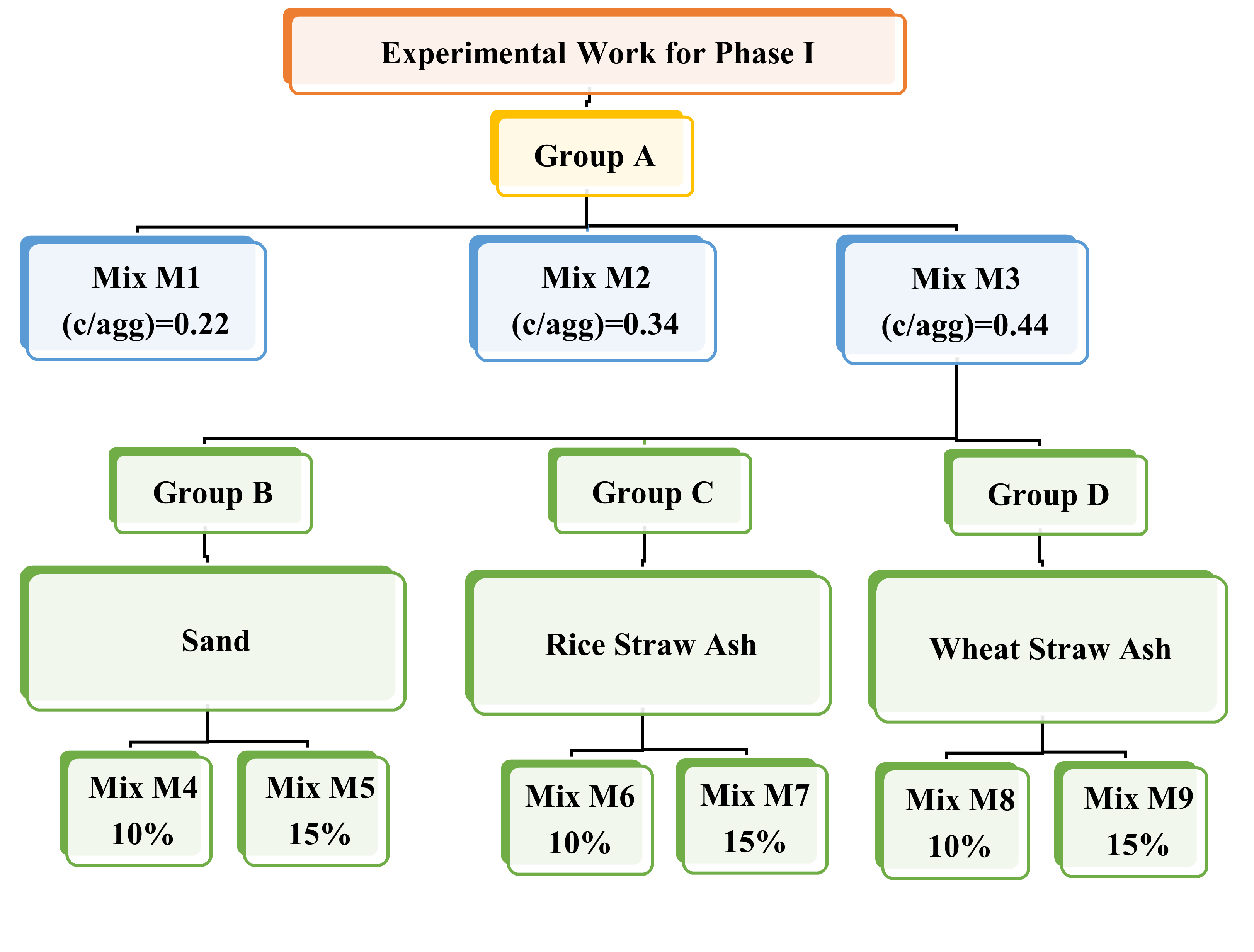
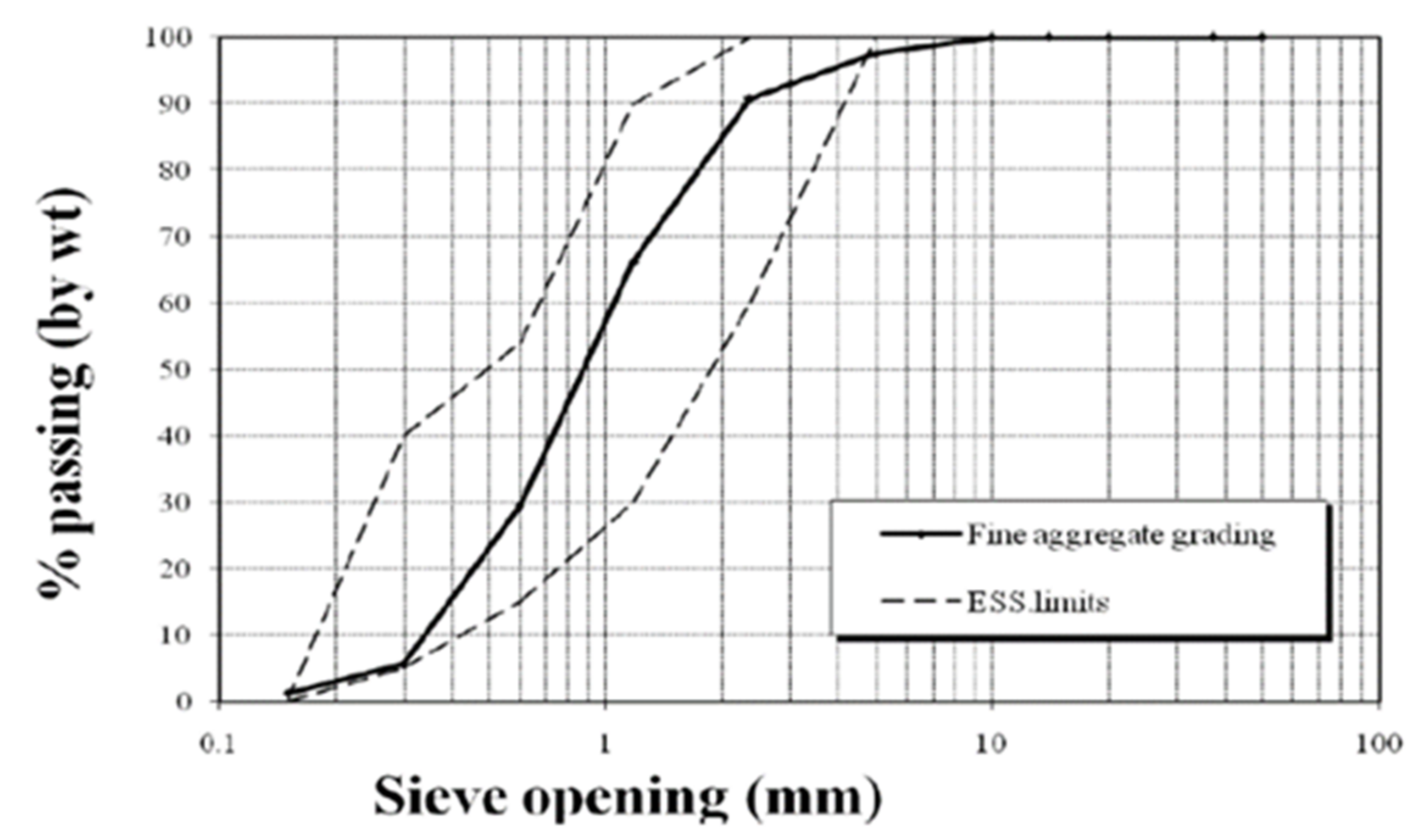
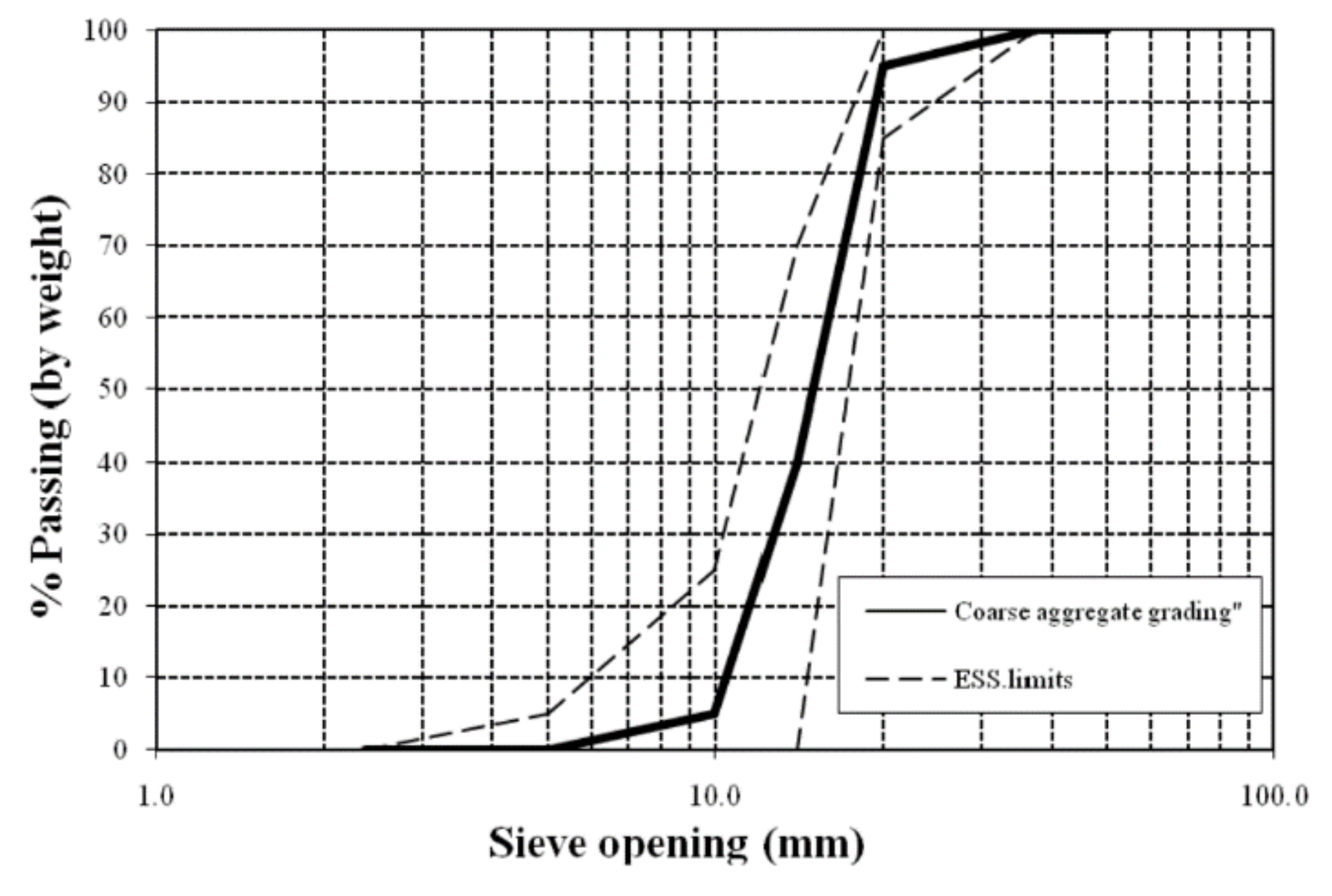


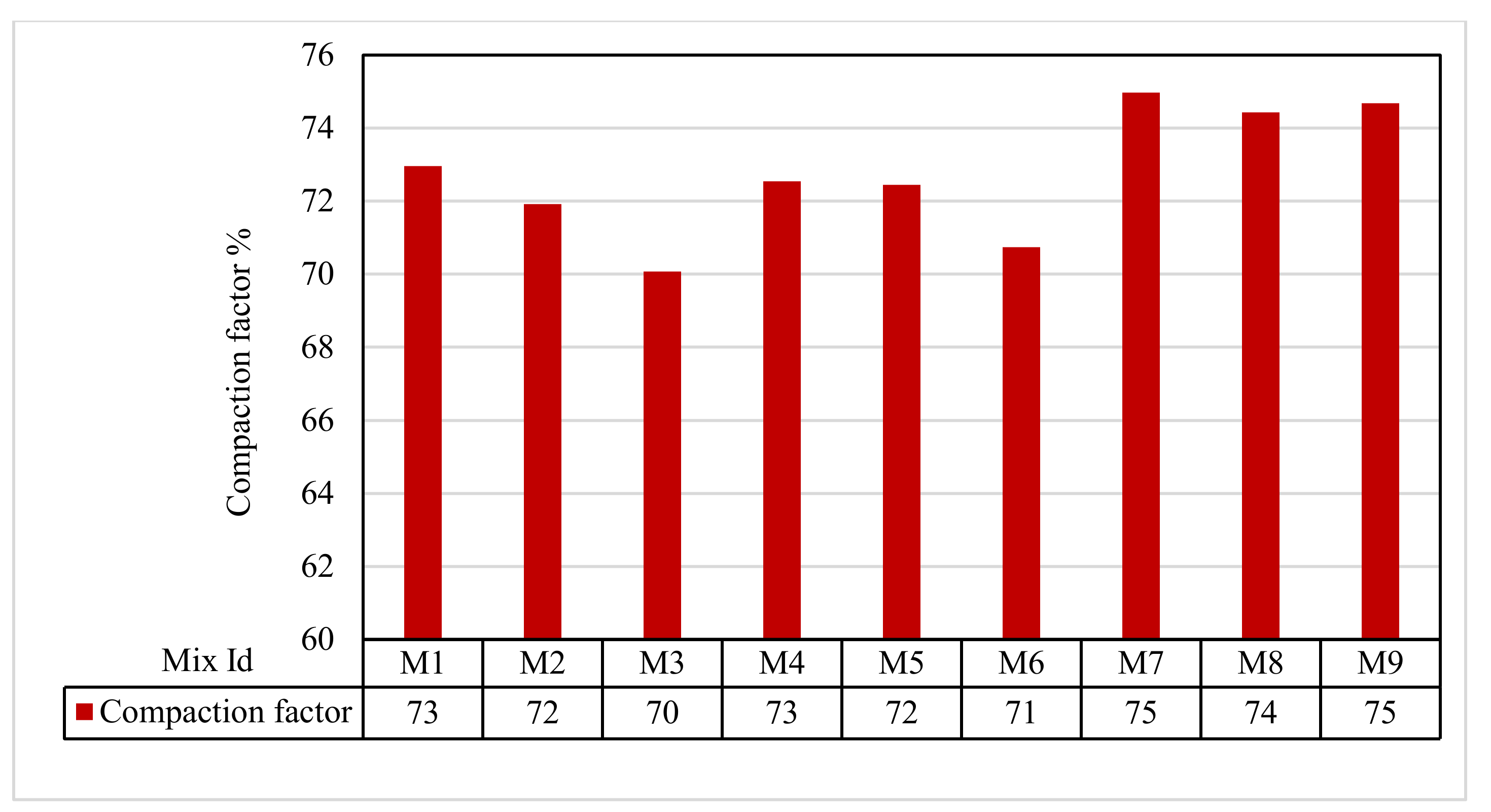
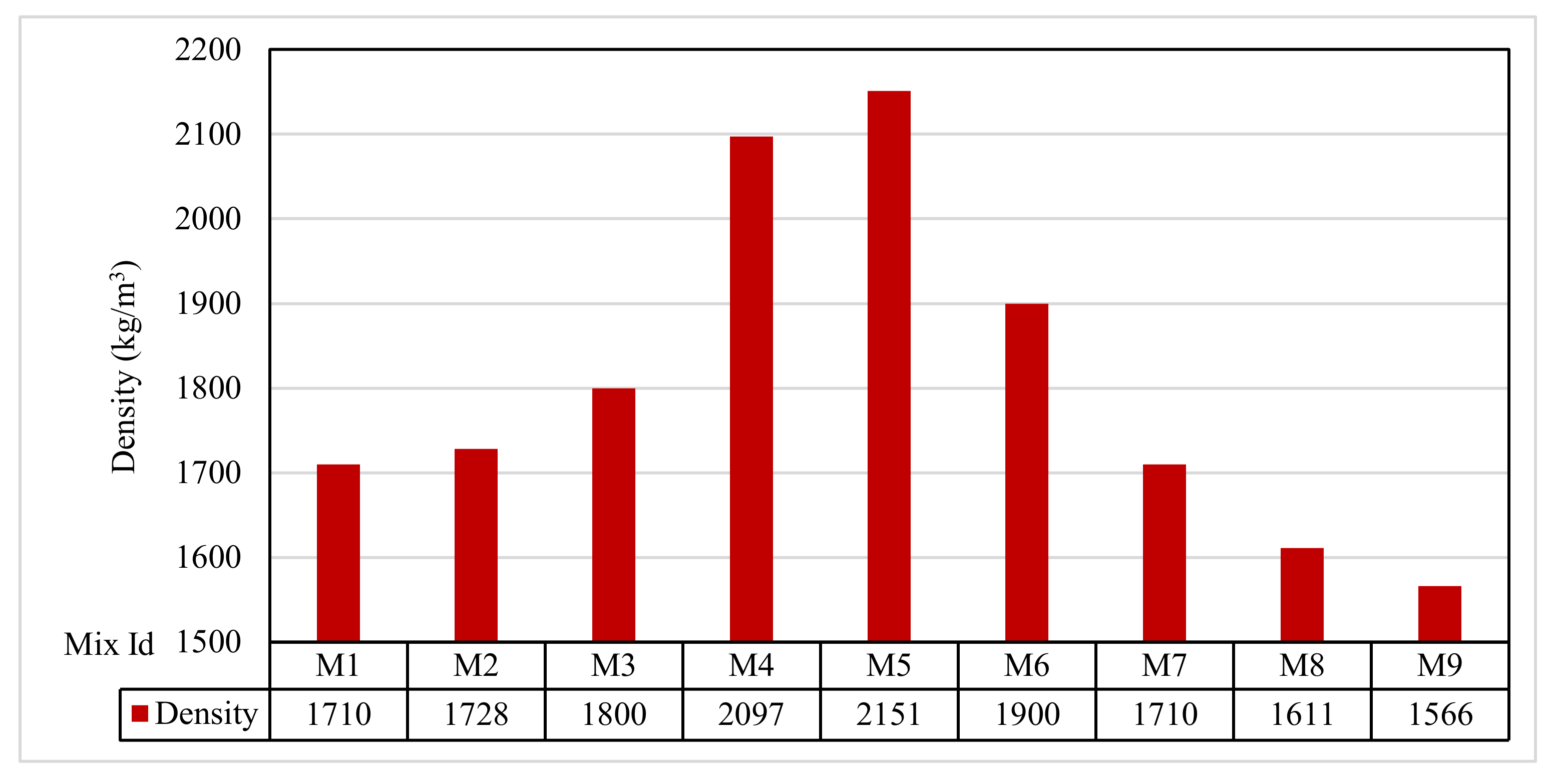



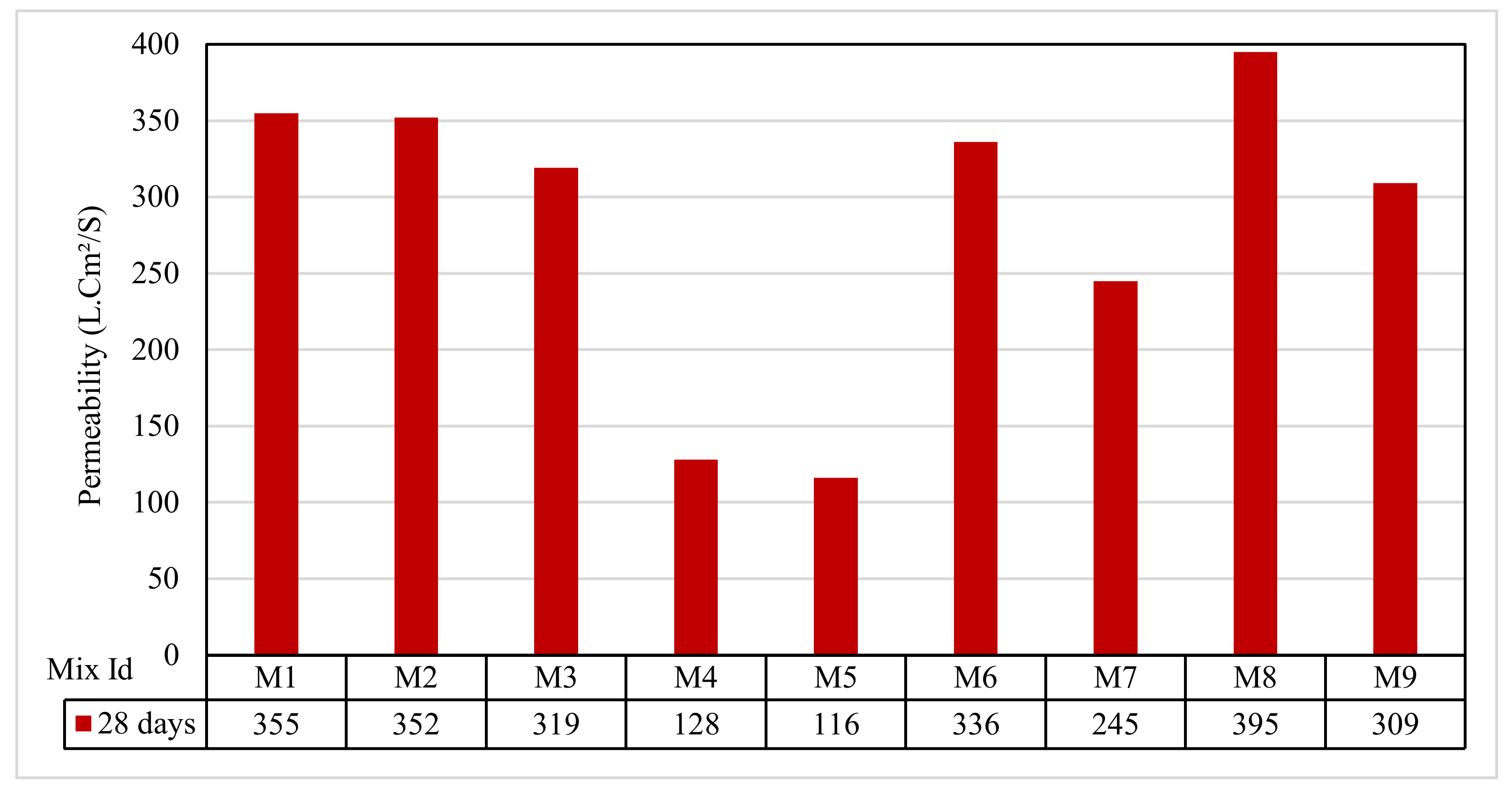
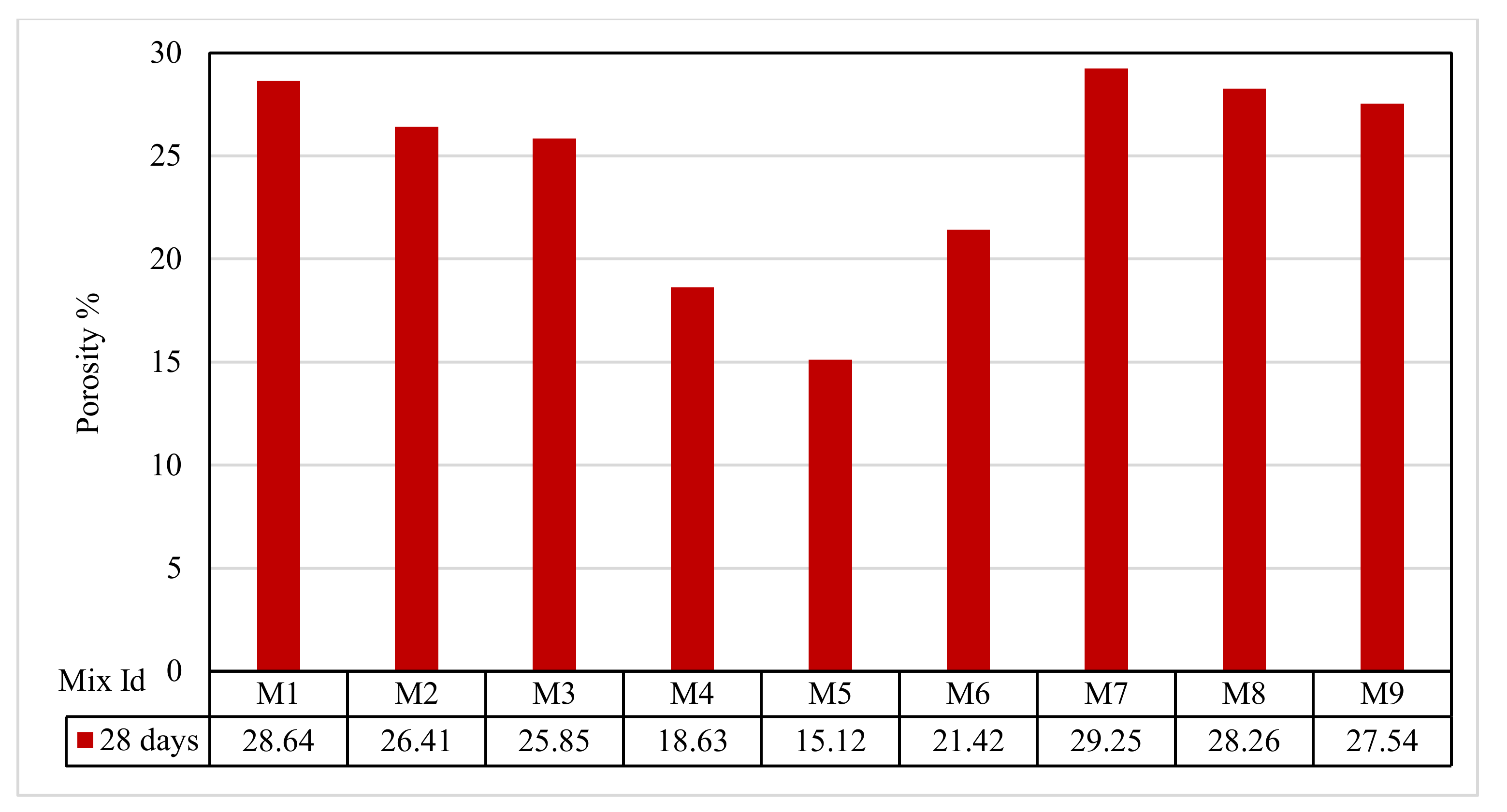

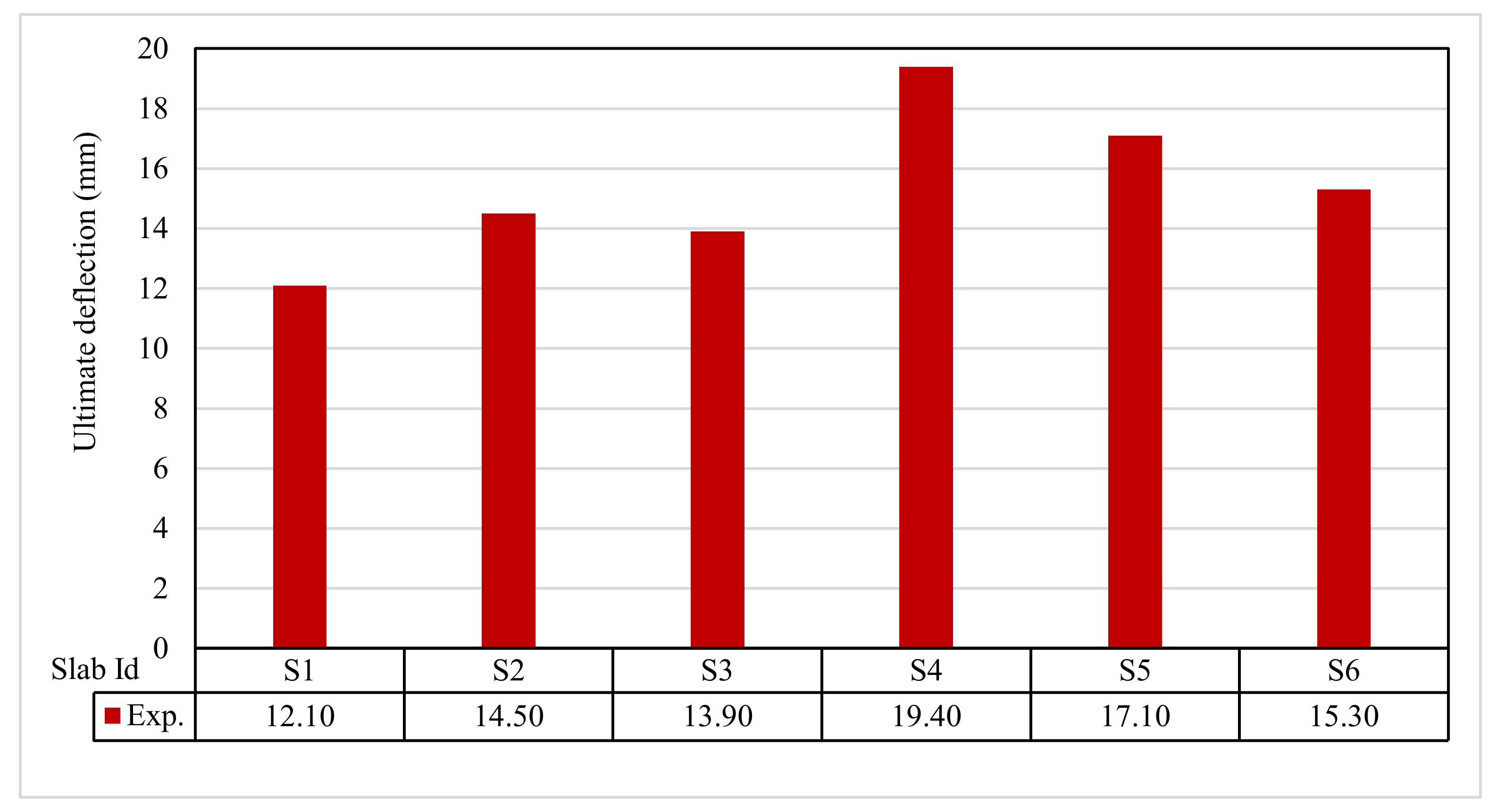



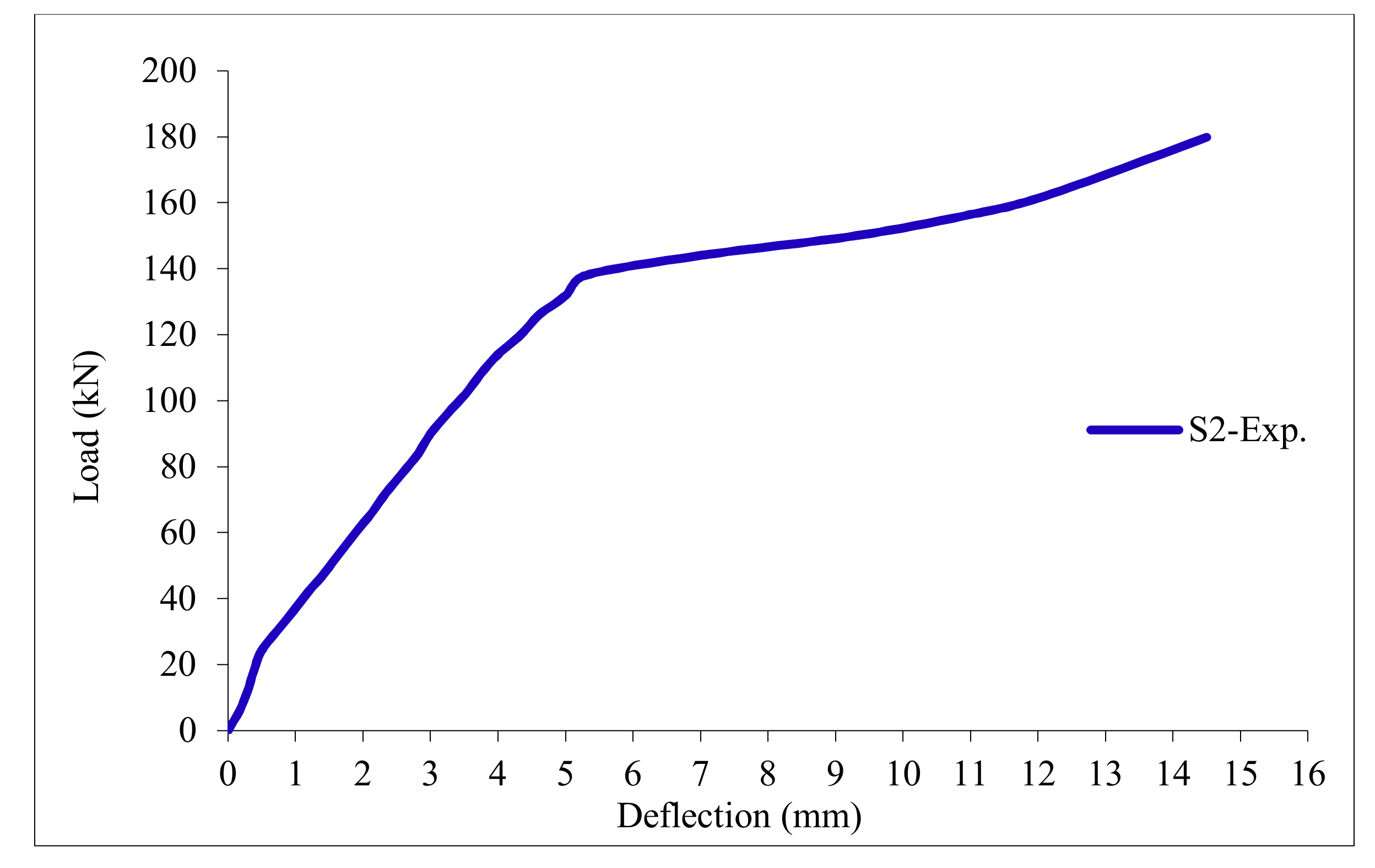
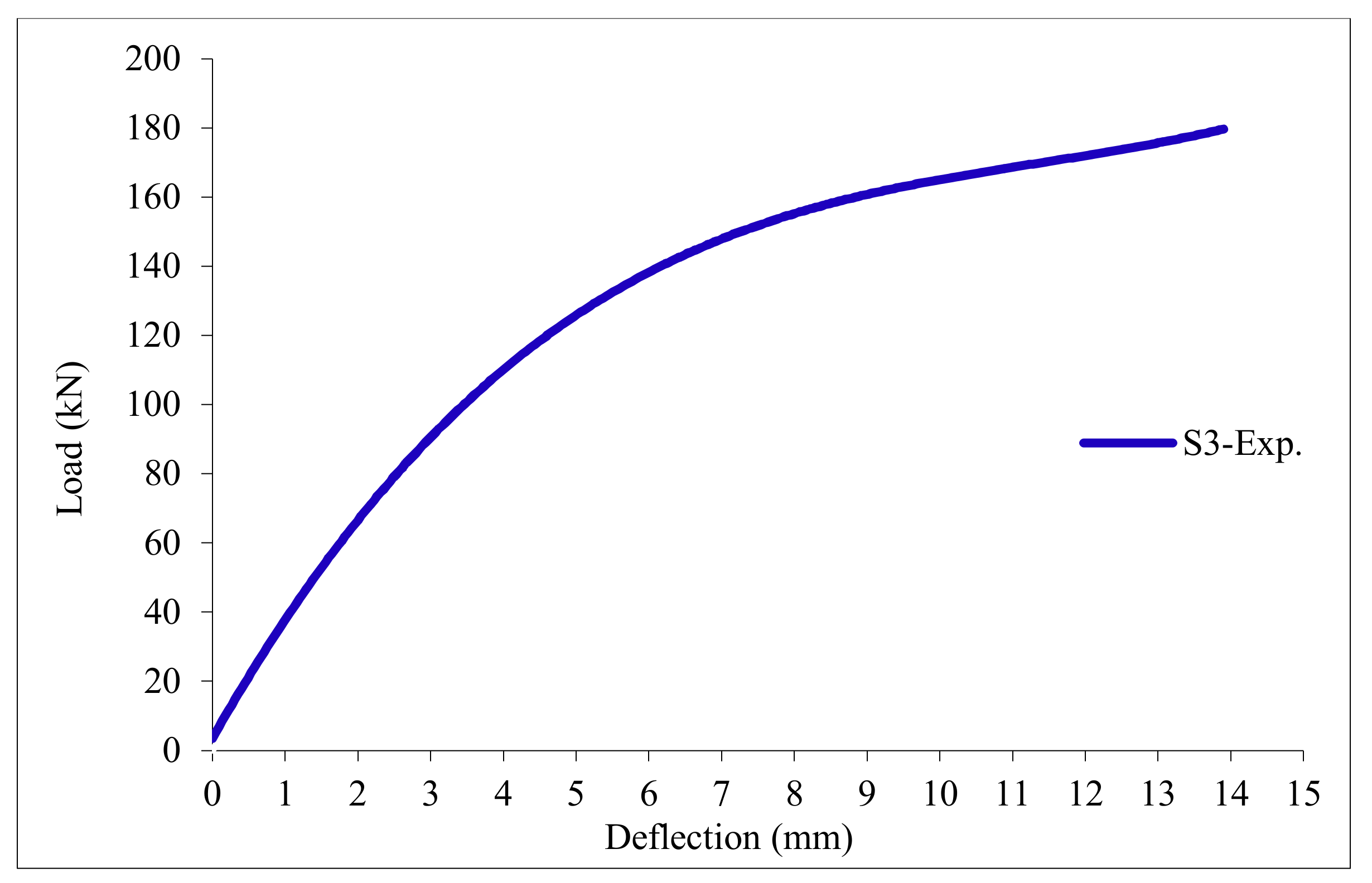
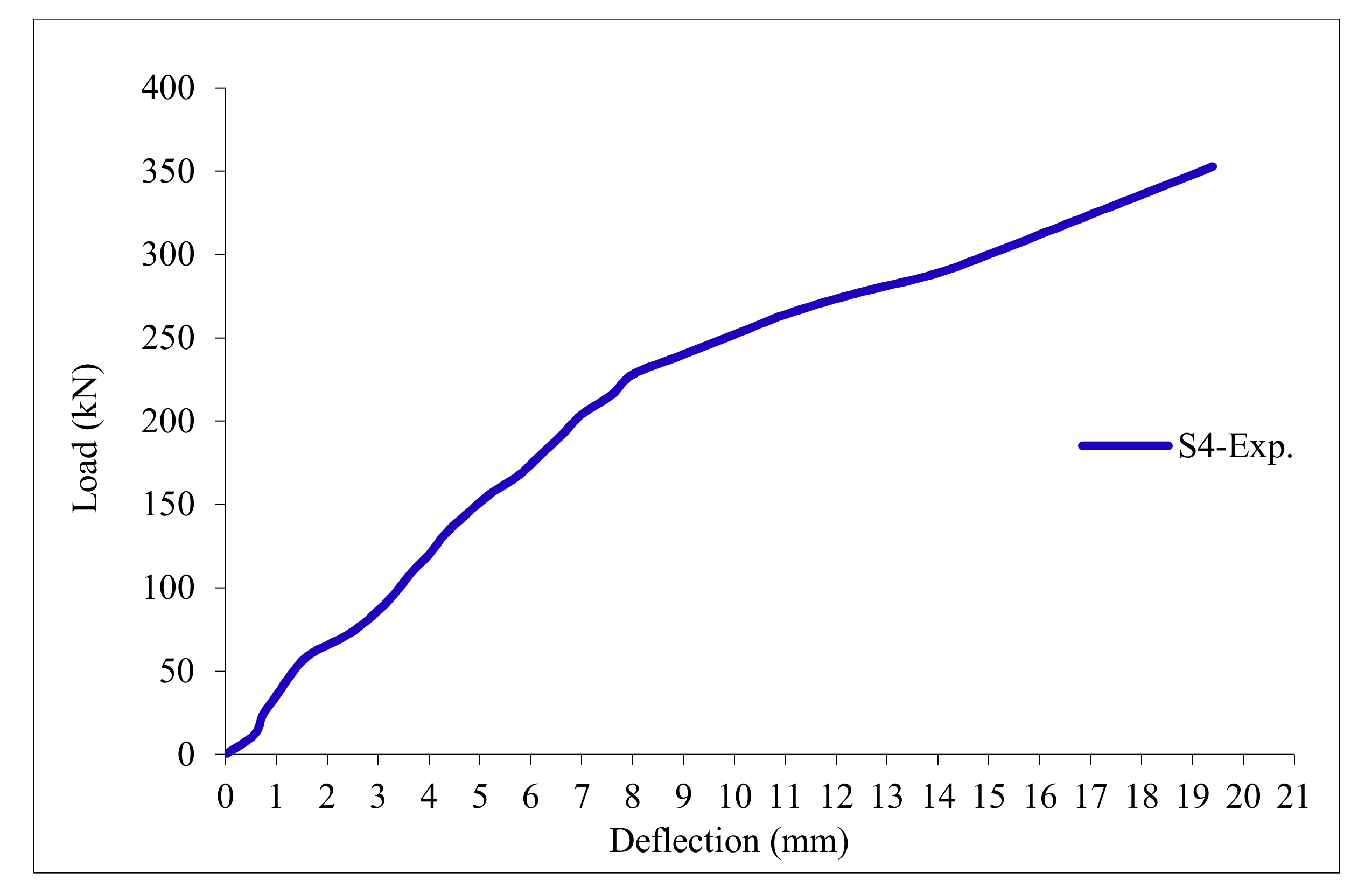

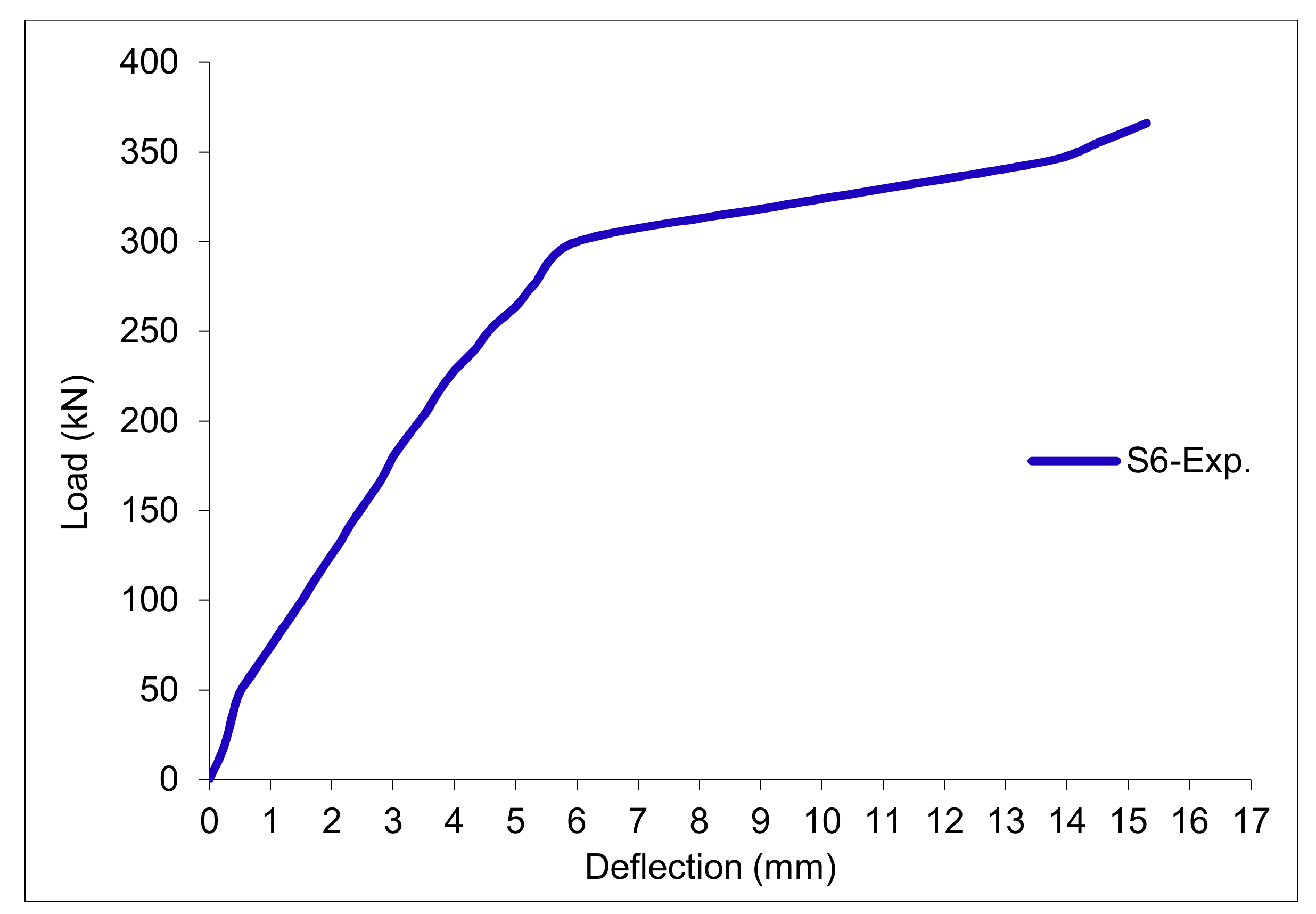

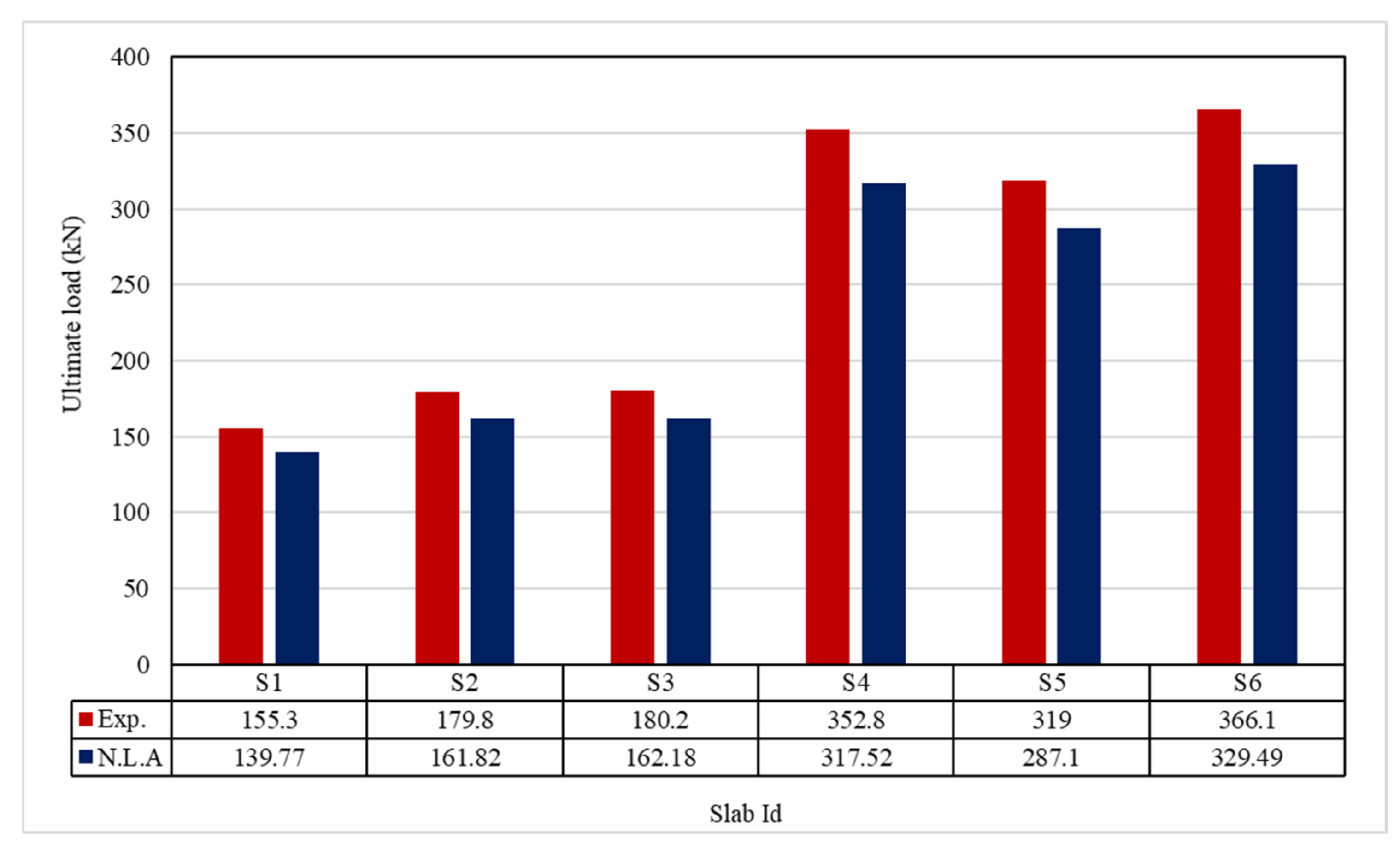



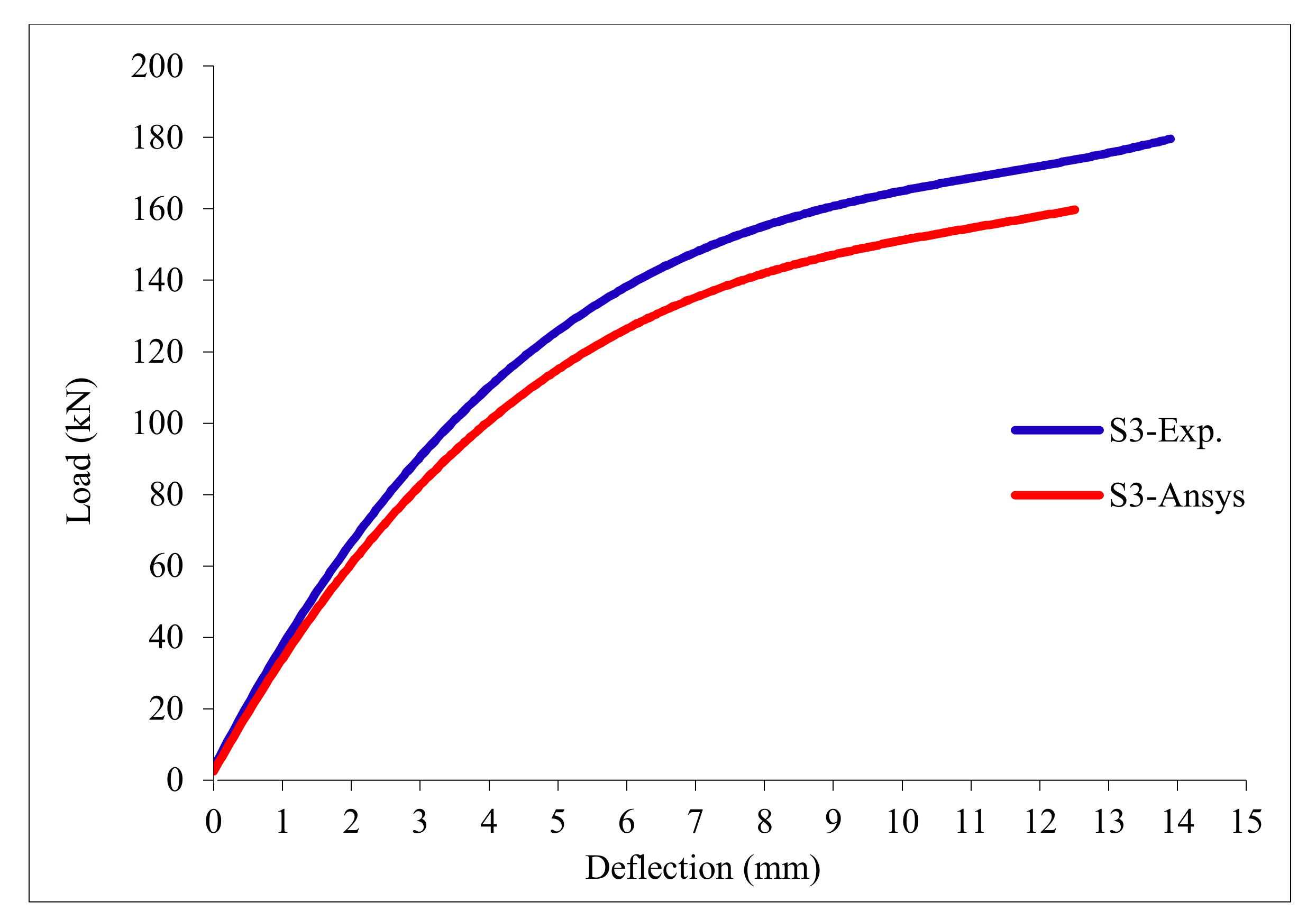

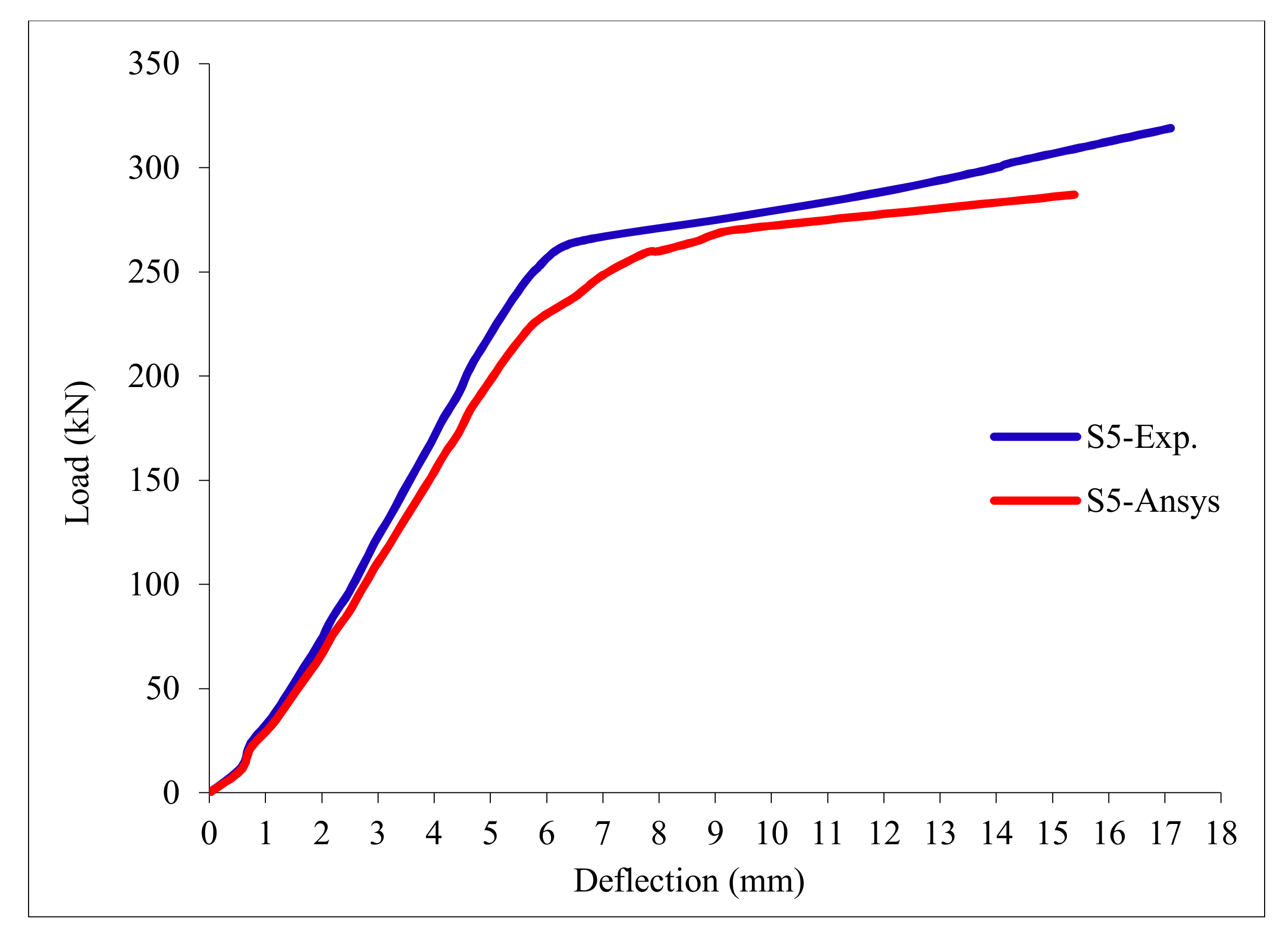
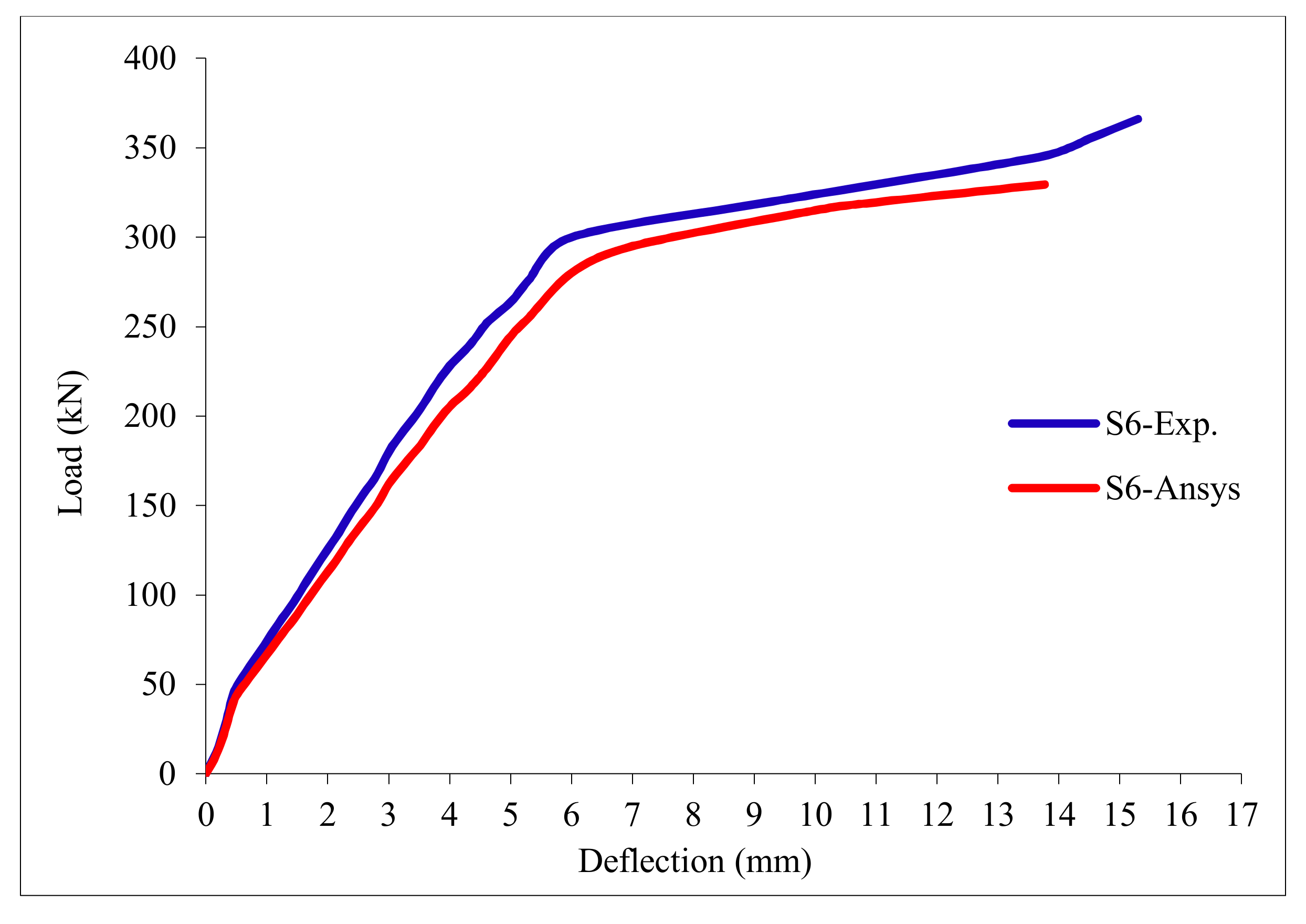
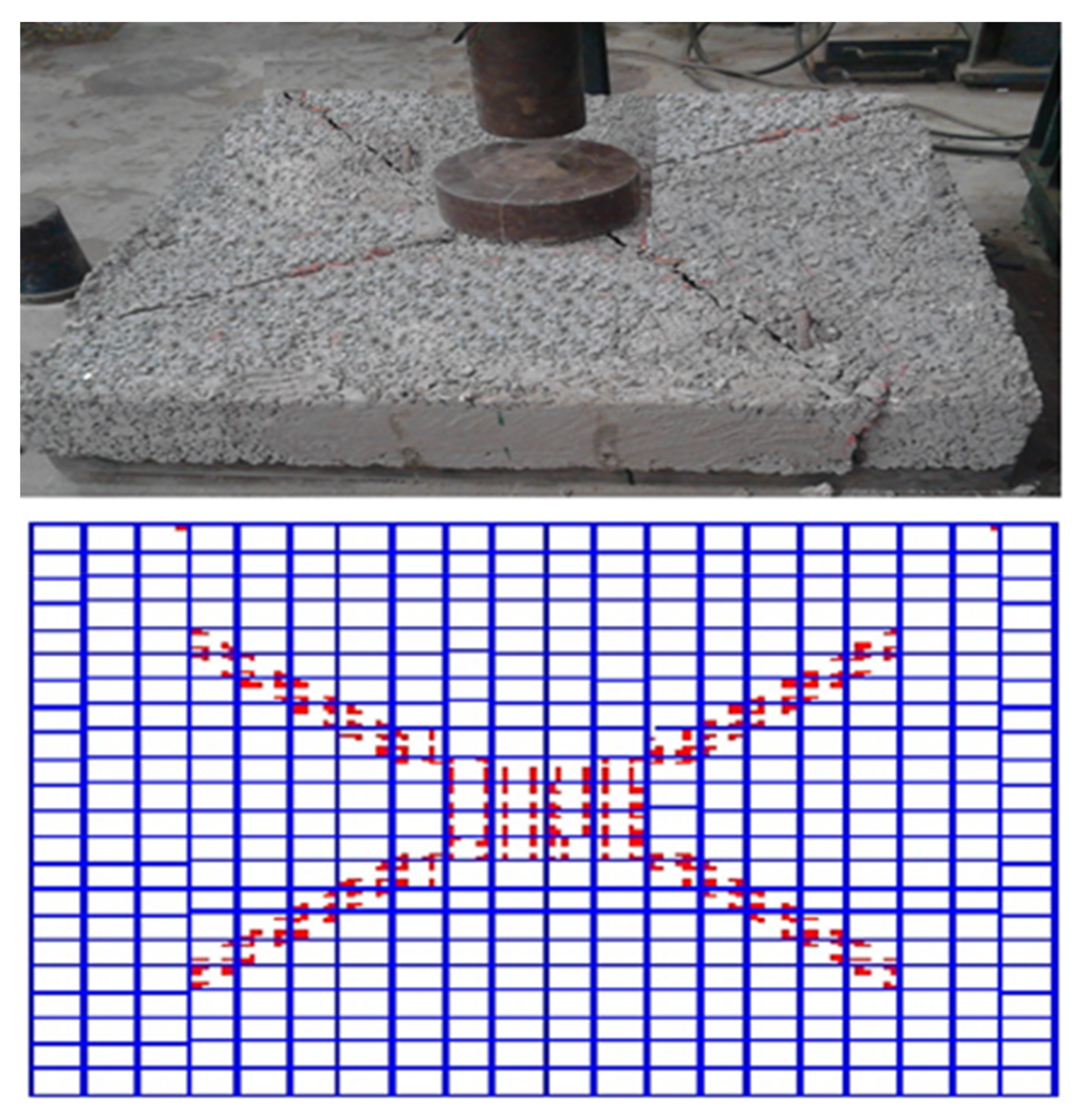
| Item | Mix No. | Cement (kg/m3) | Coarse Aggregate (kg/m3) | Fine Aggregate (kg/m3) | Rice Straw Ash (kg/m3) | Wheat Straw Ash (kg/m3) | Water (kg/m3) | W/B | Superplasticizer (kg/m3) |
|---|---|---|---|---|---|---|---|---|---|
| Per m3 of concrete | M1 | 400 | 1750 | --- | --- | --- | 95 | 0.238 | 2 |
| M2 | 400 | 1167 | --- | --- | --- | 95 | 0.238 | 2 | |
| M3 | 400 | 900 | --- | --- | --- | 95 | 0.238 | 2 | |
| M4 | 400 | 900 | 100 | --- | --- | 95 | 0.238 | 2 | |
| M5 | 400 | 900 | 150 | --- | --- | 95 | 0.238 | 2 | |
| M6 | 360 | 900 | --- | 40 | --- | 95 | 0.238 | 2 | |
| M7 | 340 | 900 | --- | 60 | --- | 95 | 0.238 | 2 | |
| M8 | 360 | 900 | --- | --- | 40 | 95 | 0.238 | 2 | |
| M9 | 340 | 900 | --- | --- | 60 | 95 | 0.238 | 2 |
| Property | Results | EES Acceptance Limits * |
|---|---|---|
| Specific gravity (kg/m3) | 2.50 | − |
| Unit weight (kg/m3) | 1620 | − |
| Materials finer than no. 200 sieve (0.074 mm) % | 1.4 | Less than 4% |
| Property | Value | EES Acceptance Limits * |
|---|---|---|
| Specific gravity (kg/m3) | 2.60 | − |
| Unit weight (kg/m3) | 1600 | --- |
| Absorption Percentage | 1.46% | Not more than 2.5% |
| Clay and other fine materials (%) | 0.28% | Not more than 3% by weight |
| Abrasion value (loss angles) (%) | 31.03% | Not more than 30% |
| Crushing value (%) | 18.93% | Not more than 45% |
| Impact value (%) | ---- | Not more than 45% |
| Flakiness Index (%) | 21.33% | Not more than 25% |
| Elongation Index (%) | 4.33% | Not more than 25% |
| Property | OPC | |
|---|---|---|
| Fineness (cm2/g) | 3550 | |
| Setting time (min) | Initial | 135 |
| Final | 195 | |
| Soundness (mm) | 1 | |
| Compressive strength (N/mm2) | 2 days | 26.2 |
| 28 days | 48.6 | |
| Component | SiO2 | Al2O3 | Fe2O3 | CaO | Na2O | MgO | K2O | SO2 | Loss on Ignition | Insoluble Residue |
|---|---|---|---|---|---|---|---|---|---|---|
| Percent | 21 | 6.1 | 3 | 61.5 | 0.38 | 2.1 | 0.3 | 2.5 | 2.4 | 0.9 |
| Oxides | SiO2 | Al2O3 | Fe2O3 | CaO | MgO | Na2O | K2O | SO3 |
|---|---|---|---|---|---|---|---|---|
| RSA | 91.33 | 0.07 | 0.07 | 0.45 | 0.28 | 0.01 | 2.64 | 0.05 |
| WSA | 88.32 | 0.06 | 0.06 | 0.67 | 0.44 | 0.07 | 1.89 | 0.14 |
| Specific Gravity | 0.91 gm/cm3 |
|---|---|
| Thickness of the package | 2 mm |
| Each fiber bandle | 10 |
| Tensile strength | 370 N/mm2 |
| Young’s modulus | 3750 N/mm2 |
| Acid and Salt Resistance | High |
| Alkali Resistance | Alkali Proof |
| Surface resistance | >103 ohm |
| Volumetric resistance | >103 ohm |
| Electrical Conductivity | Low |
| Melting Point | 160 °C |
| Ignition Point | >320 °C |
| Diameter (mm) | Tensile Strength (MPa) | Strain (mm/mm) |
|---|---|---|
| 10 | 740 | 0.0120 |
| Item | Cement (kg/m3) | Coarse Aggregate (kg/m3) | Rice Straw Ash (kg/m3) | Water (kg/m3) | W/B | Superplasticizer (kg/m3) |
|---|---|---|---|---|---|---|
| Per m3 of concrete | 340 | 900 | 60 | 95 | 0.238 | 2 |
| Series | Slab ID | Slab Description | Volume of Fraction (mm3) |
|---|---|---|---|
| Control | S1 | Control | --- |
| Ploy. fibers | S2 | 0.1% ploy. fibers | 0.00270 |
| S3 | 0.2% ploy. fibers | 0.00540 | |
| Geogrid | S4 | CE121 type I | 0.00753 |
| S5 | CE121 type II | 0.01510 | |
| GFRP bars | S6 | 5φ10/m’ bars both sides | --- |
| Slab No | First Crack Load (kN) | Ultimate Load (kN) | Def. at First Crack Load (mm) | Def. at Ult. Load (mm) | Ductility Ratio % | Energy Absorption (kN.mm) |
|---|---|---|---|---|---|---|
| S1 | 45.10 | 155.30 | 3.45 | 12.10 | 3.48 | 932.58 |
| S2 | 53.40 | 179.80 | 3.53 | 14.50 | 4.11 | 1303.55 |
| S3 | 55.70 | 180.20 | 3.63 | 13.90 | 3.83 | 1252.39 |
| S4 | 72.20 | 352.80 | 4.22 | 19.40 | 4.60 | 3422.16 |
| S5 | 61.50 | 319.00 | 3.84 | 17.10 | 4.45 | 2727.45 |
| S6 | 77.80 | 366.10 | 4.91 | 15.30 | 3.12 | 2800.67 |
| Slab No | First Crack Load (kN) | Ultimate Load (kN) | Def. at First Crack Load (mm) | Def. at Ult. Load (mm) | Ductility Ratio | Energy Absorption (kN.mm) |
|---|---|---|---|---|---|---|
| S1 | 42.00 | 139.77 | 3.11 | 10.89 | 3.50 | 761.05 |
| S2 | 49.00 | 161.82 | 3.42 | 13.05 | 3.82 | 1055.88 |
| S3 | 51.00 | 162.18 | 3.59 | 12.51 | 3.48 | 1014.44 |
| S4 | 63.00 | 317.52 | 4.18 | 17.46 | 4.18 | 2771.95 |
| S5 | 59.00 | 287.10 | 3.81 | 15.39 | 4.04 | 2209.23 |
| S6 | 75.00 | 329.49 | 4.87 | 13.77 | 2.83 | 2268.54 |
| Slab No | First Crack Load (kN) | First Crack Load (kN) | Ultimate Load (kN) | Ultimate Load (kN) | Def. at Ult. Load (mm) | Def. at Ult. Load(mm) |
|---|---|---|---|---|---|---|
| NLA. | EXP. | NLA. | EXP. | NLA. | EXP. | |
| S1 | 42.00 | 45.10 | 139.77 | 155.30 | 10.89 | 12.01 |
| S2 | 49.00 | 53.40 | 161.82 | 179.80 | 13.05 | 14.50 |
| S3 | 51.00 | 55.70 | 162.18 | 180.20 | 12.51 | 13.90 |
| S4 | 63.00 | 72.20 | 317.52 | 352.80 | 17.46 | 19.40 |
| S5 | 59.00 | 61.50 | 287.10 | 319.00 | 15.39 | 17.10 |
| S6 | 75.00 | 77.80 | 329.49 | 366.10 | 13.77 | 15.30 |
Publisher’s Note: MDPI stays neutral with regard to jurisdictional claims in published maps and institutional affiliations. |
© 2021 by the author. Licensee MDPI, Basel, Switzerland. This article is an open access article distributed under the terms and conditions of the Creative Commons Attribution (CC BY) license (https://creativecommons.org/licenses/by/4.0/).
Share and Cite
El-Sayed, T.A. Performance of Porous Slabs Using Recycled Ash. Polymers 2021, 13, 3319. https://doi.org/10.3390/polym13193319
El-Sayed TA. Performance of Porous Slabs Using Recycled Ash. Polymers. 2021; 13(19):3319. https://doi.org/10.3390/polym13193319
Chicago/Turabian StyleEl-Sayed, Taha Awadallah. 2021. "Performance of Porous Slabs Using Recycled Ash" Polymers 13, no. 19: 3319. https://doi.org/10.3390/polym13193319
APA StyleEl-Sayed, T. A. (2021). Performance of Porous Slabs Using Recycled Ash. Polymers, 13(19), 3319. https://doi.org/10.3390/polym13193319






